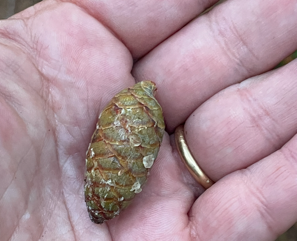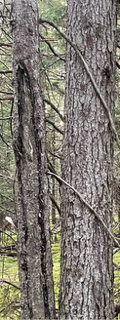I was walking my dog on a trail yesterday when we came across a tall conifer in a spruce-fir-hemlock stand that seemed to be dropping green cones. Dropping is putting it lightly! Those cones fell fast and furiously, one every couple of seconds for the three minutes we stopped to observe it. We walked a little further, maybe five minutes more, and we came across a second tree doing the same thing.


So I had a few questions about what I had seen:
- What kind of a tree was this?
- Where the cones dropping, or was something shaking them loose?
Of course I checked with my trusted resource, Google. But then I thought I’d run them by one of the tree experts I’ve met through the Maine Master Naturalist Program. I sent my questions and a couple of photos to Susan Cottle, who lives in Central Maine. She wrote back:
I’m quite sure the bark you are sharing with me is not fir. It can take a bit of time to get used to seeing how the resin blisters appear on older trees—but they are still there (jb-in the bark if the tree is indeed a fir). And fir bark does not get that fractured appearance I see in the (larger) tree in your photo… Firs don’t get fractured/scaly/ridged bark—certainly not at the size of your tree.
In terms of lots of cones dropping, I’d note that this is about time/the season for hemlock cones to drop…and, of course, our squirrelly friends are interested in the food they have inside them and in getting ready for the less fruitful, colder weather. So they could also be working on them—and that means dropping them down so they can then have a snack or gather them up to store away. I have never been in a “shower” of cones coming down, but I have been aware at times of, standing in the woods, cones dropping. Not a cascade exactly, but a fairly steady set of drops interrupted by irregular length pauses. The times I remember particularly distinctly all have involved squirrels—red squirrels (reds being the masters of cone disassembly!). So…if you were hearing a lot…perhaps you had both the season and a squirrel working on getting those cones down to the ground.
I had noted in my original email to Susan that one of my Google-based sources reported that fir cones don’t fall to the ground intact. Since these cones were all intact, and since they were too small to be spruce cones and were obviously not pine cones, I guessed these were hemlock cones (cone size being another important way of identifying amongst the pine family). Susan warned me away from any statement that included the word “always” — but added that she had not heard that before. So I sent her the link to the Purdue University Landscape Report’s “Conifer cone production” page.
Almanac
Today’s Forecast: Sunny conditions will continue all day. Wind gusts are up to 9 mph.
| Weather | ||
|---|---|---|
| Low Temperature: 56 | High Temperature: 66 | Precipitation (in): 0 |
| Wind Direction: SSE | Max Wind (mph): 9 | |
| Sunrise: 6:02 | Sunset: 7:04 | |
| Lunar Phase: Waxing Gibbous | Days to Next Full: 3 |
References
filters:
and:
- date==this.date
- file.folder.contains("Periodics")
views:
- type: table
name: Daily Almanac
order:
- file.name
- forecast
- low temp
- hi temp
- precip
- wind dir
- max wind
- moon
- days-to-full
- sunrise
- sunset
columnSize:
property.forecast: 286